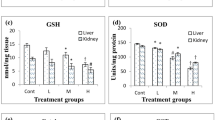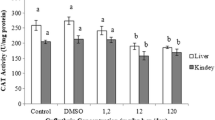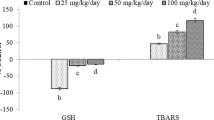Abstract
Epoxiconazole (EPX) is a triazole fungicide commonly used in agriculture and for domestic purposes around the world. The excessive application of this pesticide may result in a variety of adverse effects on non-target organisms, including humans. Since, the liver and kidneys are the target organs of this fungicide, potential hepatotoxic and nephrotoxic effects are of high relevance. Thus, our study aimed to investigate the toxic effects of EPX on the liver and kidney of Wistar rats. The exposure of rats to EPX at these concentrations (8, 24, 40, 56 mg/kg bw representing, respectively, NOEL (no observed effect level), NOEL × 3, NOEL × 5, and NOEL × 7) for 28 days significantly enhances hepatic and renal lipid peroxidation which is accompanied by an increase in the level of protein oxidation. Furthermore, the results of the present study clearly indicated that EPX administration induces an increase in the levels of DNA damage in a dose-dependent manner. In addition, the activities of liver and kidney antioxidant enzymes such as superoxide dismutase (SOD), catalase (CAT), glutathione peroxidase (GPx), and glutathione S-transferase (GST) are increased significantly in EPX-treated rats at concentrations of 8, 24, and 40 mg/kg bw. However, with the dose NOEL × 7 (56 mg/kg bw of EPX), the activities of CAT, GPx, and GST are decreased. Indeed, EPX-intoxicated rats revealed a significant reduction in acetylcholinesterase (AChE) activity in both liver and kidney compared with the control group. Also, our results demonstrated that the EPX administration leads to a disruption of the hepatic (aspartate aminotransferase (AST), alanine aminotransferase (ALT), alkaline phosphatase (ALP), and lactate dehydrogenase (LDH)) and renal (uric acid and creatinine) functions. The biochemical perturbations obtained in the present study are corroborated with the histopathological modifications. Since EPX treatment caused severe damage in the overall histo-architecture of liver and kidney tissues, these results suggest that administration of EPX induced a marked deregulation of liver and kidney functions.

Graphical abstract










Similar content being viewed by others
References
Abdelhady DH, El-Magd MA, Elbialy ZI, Saleh AA (2017) Bromuconazole-induced hepatotoxicity is accompanied by upregulation of PXR/CYP3A1 and downregulation of CAR/CYP2B1 gene expression. Toxicol Mech Methods 27:150–165
Acuna LG, Calderon IL, Elias AO, Castro ME, Vasquez CC (2009) Expression of the ygg E gene protects Escherichia coli from potassium tellurite-generated oxidative stress. Arch Microbiol 191:473–476
Allen JW, Wolf DC, George MH, Hester SD, Sun G, Thai SF, Delker DA, Moore T, Jones C, Nelson G, Roop BC, Leavitt S, Winkfield E, Ward WO, Nesnow S (2006) Toxicity profiles in mice treated with hepatotumorigenic and non hepatotumorigenic triazole conazole fungicides: propiconazole, triadimefon, and myclobutanil. Toxicol Pathol 34:853–862
Amara A, Quiniou F, Durand G, El Bour M, Boudabous A, Hourmant A (2013) Toxicity of epoxiconazole to the marine diatom Chaetoceros calcitrans: influence of growth conditions and algal development stage. Water Air Soil Pollut 224:1–9
Beers RFJ, Sizer I (1951) A spetrophotometric method for measuring the breakdown of hydrogen peroxide by catalase. J Biol Chem 195:133–140
Ben Saad H, Feki A, Boudawara O, Hakim A, Ben Amara I (2017) 2017. Effects of selenium on tebuconazole-induced hepatotoxicity in adult rats. J Pharmacogn Phytochem 6:105–109
Bhinder P, Chaudhry A (2013) Mutagenicity assessment of organophosphates using polymerase chain reaction-restriction fragment length polymorphism assay. Int J Toxicol 20:254–260
Bolton JL, Chang M (2001) Quinoids as reactive intermediates in estrogencarcinogenesis. Adv Exp Med Biol 500:497–507
Bradford MM (1976) A rapid and sensitive method for the quantification of microgram quantities of protein utilizing the principle of protein-dye binding. Anal Biochem 72:248–254
Bruno M, Moore T, Nesnow S, Ge Y (2009) Protein carbonyl formation in response to propiconazole-induced oxidative stress. J Proteome Res 8:2070–2078
Cao J, Chen J, Xie L, Wang J, Feng C, Song J (2015) Protective properties of sesamin against fluoride-induced oxidative stress and apoptosis in kidney of carp (Cyprinus carpio) via JNK signaling pathway. Aquat Toxicol 167:180–190
Chaâbane M, Koubaa M, Soudani N, Elwej A, Grati M, Jamoussi K, Boudawara T, Chaabouni SE, Zeghal N (2017) Nitraria retusa fruit prevents penconazole-induced kidney injury in adult rats through modulation of oxidative stress and histopathological changes. Pharm Biol 55:1061–1073
Chambers JE, Greim H, Kendall RJ, Segner H, Sharpe RM, Van Der Kraak G (2014) Human and ecological risk assessment of a crop protection chemical: a case study with the azole fungicide epoxiconazole. Crit Rev Toxicol 44:176–210
Chen PJ, Moore T, Nesnow S (2008) Cytotoxic effects of propiconazole and its metabolites in mouse and human hepatoma cells and primary mouse hepatocytes. Toxicol in Vitro 22:1476–1483
Collins AR, Dusinska M, Gedik CM, Stetina R (1996) Oxidative damage to DNA: do we have a reliable biomarker? Environ Health Perspect 104:465–469
Coppage DL, Bradeich E (1976) River pollution by anti-cholinesterase agent. Water Res 10:19–24
Council of European Communities (1986) Council instructions about the protection of living animals used in scientific investigations. Off J Eur Communities (JO86/609/CEE) L358:1–18
De Castro VL, Maia AH (2012) Prenatal epoxiconazole exposure effects on rat postnatal development. Birth Defects Research Part B: Developmental and Reproductive Toxicology 95:123–129
EFSA Scientific Report (2008a) Conclusion on the peer review of epoxiconazole, vol 138, pp 1–80
EFSA Scientific Report (2008b) Conclusion on the peer review of penconazole, vol 175, pp 1–104 http://www.efsa.europa.eu
El-Demerdash FM, Yousef IM, Kedwany FS, Baghdadi HH (2004) Cadmium induced changes in lipid peroxidation, blood hematology, biochemical parameters and serum quality of male rats: protective role of vitamin E and b-carotene. Food Chem Toxicol 42:1563–1571
Ellman GL, Courtney KD, Andres V, Feather-Stone RM (1961) A new and rapid colorimetric determination of acetylcholinesterase activity. Biochem Pharmacol 7:88–95
El-Sebae AH, Enan EE, El-Fiki SA, Khamees E (1981) Biochemical effects of some organophosphorus insecticides on new targets in white rats. J Environ Sci Health B 16:475–491
Flohe L, Gunzler WA (1984) Assays of glutathione peroxidase. Methods Enzymol 105:114–121
Fuhrman B, Partoush A, Aviram M (2004) Acetylcholine esterase protects LDL against oxidation. Biochem Biophys Res Commun 322:974–978
Galal MK, Khalaf AAA, Ogaly HA, Ibrahim MA (2014) Vitamin E attenuates neurotoxicity induced by deltamethrin in rats. BMC Complement Altern Med 14:458–465
Gathwan KH, Al-Karkhi IH, Yaseen AK (2013) Organophosphorous insecticides induced alterations in liver of male albino rats. Chem Sci Trans (2):S95–S98
Goetz AK, Ren HZ, Schmid JE, Blystone CR, Thillainadarajah I, Best DS, Nichols HP, Strader LF, Wolf DC, Narotsky MG (2007) Disruption of testosterone homeostasis as a mode of action for the reproductive toxicity of triazole fungicides in the male rat. Toxicol Sci 95:227–239
Greim H, Saltmiras D, Mostert D, Strupp C (2015) Evaluation of carcinogenic potential of the herbicide glyphosate, drawing on tumor incidence data from fourteen chronic/carcinogenicity rodent studies. Crit Rev Toxicol 45:185–208
Guengerich FP (2017) Intersection of the roles of cytochrome P450 enzymes with xenobiotic and endogenous substrates: relevance to toxicity and drug interactions. Chem Res Toxicol 30:2–12
Habig WH, Pabst MJ, Jakoby WB (1974) Glutathione S-transferases, the first enzymatic step in mercapturic acid formation. J Biol Chem 249:7130–7139
Hass U, Boberg J, Christiansen S, Jakobsen, PR, Vinggaard AM, Taxvig C, Poulsen ME, Herrmann SS, Jensen BH, Petersen A, Clemmensen LH, Axelstad M (2012) Adverse effects on sexual development in rat offspring after low dose exposure to a mixture of endocrine disrupting pesticides. Reprod Toxicol 34:261–274
Hattab S, Boughattas I, Boussetta H, Viarengo A, Banni M, Sforzini S (2015) Transcriptional expression levels and biochemical markers of oxidative stress in the earthworm Eisenia andrei after exposure to 2 4-dichlorophenoxyacetic acid (2, 4-D). Ecotoxicol Environ Saf 122:76–82
Heise T, Schmidt F, Knebel C, Rieke S, Haider W, Pfeil R, Kneuer C, Niemann L, Marx-Stoelting P (2015) Hepatotoxic effects of (tri) azole fungicides in a broad dose range. Arch Toxicol 89:2105–2117
Heise T, Schmidt F, Knebel C, Rieke S, Haider W, Geburek I, Marx-Stoelting P (2017) Hepatotoxic combination effects of three azole fungicides in a broad dose range. Arch Toxicol 92(2):859–872
Hester S, Moore T, Padgett WT, Murphy L, Wood CE, Nesnow S (2012) The Hepatocarcinogenic conazoles: cyproconazole, epoxiconazole, and propiconazole induce a common set of toxicological and transcriptional responses. Toxicol Sci 127:54–65
Hou Y, Zeng Y, Li S, Qi L, Xu W, Wang H, Zhao X, Sun C (2014) Effect of quercetin against dichlorvos induced nephrotoxicity in rats. Exp Toxicol Pathol 66:211–218
Kalender S, Kalender Y, Durak D, Ogutcu A, Uzunhisarcikli M, Cevrimli BS, Yildirim M (2007) Methyl parathion induced nephrotoxicity in male rats and protective role of vitamins C and E. Pestic Biochem Physiol 88:213–218
Kassirer JP (1971) Clinical evaluation of kidney function. N Engl J Med 285:385–389
Khan KH (1996) Integrated pest management and sustainable agriculture, vol 30. Farmer and Parliament, pp 15–17
Khan PK, Sobti RC, Kataria L (2005) Pesticide-induced alteration in mice hepatooxidative status and protective effect of black tea extract. Clin Chim Acta 358:131–138
Kidwell J (2007) Cyproconazole: fourth report on the Cancer Assessment Review Committee PC Code 128993. U.S. Environmental Protection Agency, Office of Pesticide Programs Health Effects Division, Washington, DC
Koner BC, Banerjee BD, Ray A (1988) Organochlorine pesticide induced oxidative stress and immune suppression in rats. Indian J Exp Biol 36:395–398
Konwick BJ, Garrison AW, Avants JK, Fisk AT (2006) Bioaccumulation and biotransformation of chiral triazole fungicides in rainbow trout (Oncorhynchus mykiss). Aquat Toxicol 80:372–381
Kostaropoulos I, Papadopoulos AI, Metaxakis A, Boukouvala E, Papadopoulou-Mourkidou E (2001) Glutathione S-transferase in the defense against pyrethroids in insects. Insect Biochem Mol Biol 31:313–319
Kumar K.S. 2000. Biological basis of assessment of ecotoxicology of pesticides on soil organisms. Masters Thesis, Centre for Environment, Jawaharlal Nehru Technological University, Hyderabad, India;
Lamb DC, Cannieux M, Warrilow AGS, Bak S, Kahn RA, Manning NJ, Kelly DE, Kelly SL (2001) Plant sterol 14α-demethylase affinity for azole fungicides. Biochem Biophys Res Commun 284:845–849
Li ZH, Randak T (2009) Residual pharmaceutically active compounds (PhACs) in aquatic environment-status, toxicity and kinetics: a review, vol 52. Veterinární medicína-Czech, pp 295–314
Malmezat T, Breuille D, Capitan P, Mirand PP, Obled C (2000) Glutathione turnover is increased during the acute phase of sepsis in rats. Nutr J 130:1239–1246
Mansour SA, Mossa AH (2010) Oxidative damage, biochemical and histopathological alterations in rats exposed to chlorpyrifos and the antioxidant role of zinc. Pestic Biochem Physiol 96:14–23
Marklund S, Marklund G (1974) Involvement of the superoxide anion radical in the autoxidation of pyrogallol and a convenient assay for superoxide dismutase. Eur J Biochem 47:469–474
Menegola E, Broccia ML, Di F, Renzo GE (2006) Postulated pathogenic pathway in triazole fungicide induced dysmorphogenenic effects. Reprod Toxicol 22:186–195
Mercier Y, Gatellier P, Renerre M (2004) Lipid and protein oxidation in vitro, and antioxidant potential in meat from Charolais cows finished on pasture or mixed diet. Meat Sci 66:467–473
Mossa AH, Abbassy MA (2012) Adverse haematological and biochemicaleffects of certain formulated insecticides in male rats. Res J Environ Toxicol 6:160–168
Mossa AH, Refaie AA, Ramadan A (2011) Effect of exposure to mixture of four organophosphate insecticides at no observed adverse effect level (NOAEL) dose on rat liver: the protective role of vitamin C. Res J Environ Toxicol 5:323–335
Mustafa SA, Karieb SS, Davies SJ, Jha AN (2015) Assessment of oxidative damage to DNA transcriptional expression of key genes, lipid peroxidation and histopathological changes in carp Cyprinus carpio L. following exposure to chronic hypoxic and subsequent recovery in normoxic conditions. Mutagenesis 3:107–116
Narra MR, Rajender K, Reddy RR, Murty US, Begum G (2017) Insecticides induced stress response and recuperation in fish: biomarkers in blood and tissues related to oxidative damage. Chemosphere 168:350–357
Nesnow S, Ward W, Moore T, Ren H, Hester SD (2009) Discrimination of tumorigenic triazole conazoles from phenobarbital by transcriptional analyses of mouse liver gene expression. Toxicol Sci 110:68–83
Ogutcu A, Suludere Z, Kalender Y (2008) Dichlorvos-induced hepatotoxicity in rats and the protective effects of vitamins C and E. Environ Toxicol Pharmacol 26:355–361
Ohkawa H, Ohishi N, Yagi K (1979) Assay for lipid peroxide in animal tissues by thiobarbituric acid reaction. Anal Biochem 95:351–358
Parke DV, Piotrowski JK (1996) Glutathione: its role in detoxication of reactive oxygen and environmental chemicals. Acta Pol Toxicol 4:1–14
Piao MJ, Kang KA, Lee IK, Kim HS, Kim S, Choi JY, Choi J, Hyun JW (2011) Silver nanoparticles induce oxidative cell damage in human liver cells through inhibition of reduced glutathione and induction of mitochondria-involved apoptosis. Toxicol Lett 201:92–100
Reitman S, Frankel S (1957) A colorimetric method for the determination of serum glutamic oxalacetic and glutamic pyruvic transaminases. Am J Clin Pathol 28:56–63
Roelofs MJE, Temming AR, Piersma AH, van den Berg M, van Duursen MBM (2014) Conazole fungicides inhibit Leydig cell testosterone secretionand androgen receptor activation in vitro. Toxicol Rep 1:271–283
Sakr SA (2007) Ameliorative effect of ginger (Zingiber officinale) on mancozeb fungicide induced liver injury in albino rats. Aust J Basic Appl Sci 1:650–656
Salvi M, Battaglia V, Brunati AM, La Rocca N, Tibaldi E, Pietrangeli P, Marcocci L, Mondovi B, Rossi CA, Toninello A (2007) Catalase takes part in rat liver mitochondria oxidative stress defense. J Biol Chem 282:24407–24415
Satpute RM, Pawar PP, Puttewar S, Sawale SD, Ambhore PD (2017) Effect of resveratrol and tetracycline on the subacute paraquat toxicity in mice. Human Exp Toxicol 36:1303–1314
Schmidt U, Schluter G (1985) Interaction of azole-derivatives with liver microsomes in rats and dogs: studies in vivo and in vitro. Proceedings of the fifth international conference on cytochrome P450, Budapest, Hungary, August 21–24, 327–30
Silman I, Sussman JL (2005) Acetylcholinesterase: “classical” and “non-classical” functions and pharmacology. Curr Opin Pharmacol 5:293–302
Tietz NW, Pruden EL, Siggaard-Andersen O, Burtis CA, Ashwell ER (1994) Tietz textbook of clinical chemistry. WB Saunders Company, London, pp 1354–1374
Tietz NW (1995) Clinical guide to laboratory tests, 3rd ed., W.B. Saunders Company, London/Philadelphia, PA, 130–131
Uzun FG, Kalender S, Durak D, Demir F, Kalender Y (2009) Malathion-induced testicular toxicity in male rats and the protective effect of vitamins C and E. Food Chem Toxicol 47:1903–1908
Vassault A (1983) Lactate dehydrogenase. UV-method with pyruvate and NADH. In: Bergmeyer J, Grabl M (eds) Methods of enzymatic analysis. Verlag-Chemie, Deerfield Beach, FL, pp 119–126
Yang JD, Liu SH, Liao MH, Chen RM, Liu PY, Ueng TH (2018) Effects of tebuconazole on cytochrome P450 enzymes, oxidative stress, and endocrine disruption in male rats. Environ Toxicol 33:899–907
Young DS, Pestaner LC, Gibberman V (1975) Effects of drugs on clinical laboratory tests. Clin Chem 21:D431–D432
Zhu B, Liu L, Gong YX, Ling F, Wang GX (2014) Triazole-induced toxicity in developing rare minnow (Gobiocypris rarus) embryos. Environ Sci Pollut Res 21:13625–13635
Zhuang SL, Bao LL, Wang HF, Zhang M, Yang C, Zhou XY, Wu Y, Rehman K, Naranmandura H (2015) The involvement of ER-stress and ROS generation in difenoconazole-induced hepatocellular toxicity. Toxicol Res 4:1195–1203
Zou W, Yan M, Xu W, Huo H, Sun L, Zheng Z (2001) Cobalt chloride induces PC12 cells apoptosis through reactive oxygen species and accompanied by AP-1 activation. J Neurosci Res 64:646–653
Funding
This study was supported by “The Tunisian Ministry of Higher Education, Scientific Research and Technology.”
Author information
Authors and Affiliations
Corresponding author
Ethics declarations
Conflict of interest
Authors assure that there are no conflicts of interest.
Additional information
Responsible editor: Philippe Garrigues
Publisher’s note
Springer Nature remains neutral with regard to jurisdictional claims in published maps and institutional affiliations.
Rights and permissions
About this article
Cite this article
Hamdi, H., Othmène, Y.B., Ammar, O. et al. Oxidative stress, genotoxicity, biochemical and histopathological modifications induced by epoxiconazole in liver and kidney of Wistar rats. Environ Sci Pollut Res 26, 17535–17547 (2019). https://doi.org/10.1007/s11356-019-05022-3
Received:
Accepted:
Published:
Issue Date:
DOI: https://doi.org/10.1007/s11356-019-05022-3




